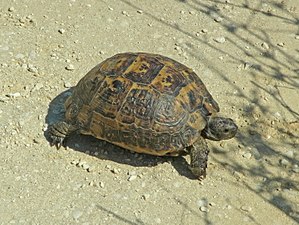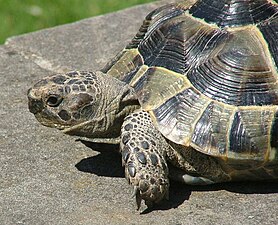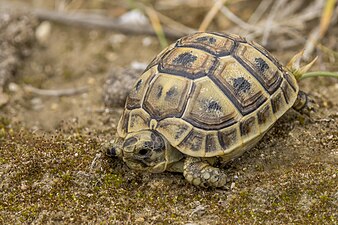Greek tortoise
This article has multiple issues. Please help improve it or discuss these issues on the talk page. (Learn how and when to remove these messages)
|
| Greek tortoise Temporal range: Possible Late Miocene record
| |
|---|---|

| |
| T. g. nabeulensis male in Tunisia | |
| Scientific classification | |
| Domain: | Eukaryota |
| Kingdom: | Animalia |
| Phylum: | Chordata |
| Class: | Reptilia |
| Order: | Testudines |
| Suborder: | Cryptodira |
| Superfamily: | Testudinoidea |
| Family: | Testudinidae |
| Genus: | Testudo |
| Species: | T. graeca
|
| Binomial name | |
| Testudo graeca | |

| |
| Note allopatric ranges of "Maghreb" (T. g. graeca) and "Greek" (T. g. ibera) populations | |
| Synonyms[2] | |
|
List
| |
Greek tortoise (Testudo graeca), also known as the spur-thighed tortoise or Moorish tortoise, is a species of tortoise in the family Testudinidae. It is one of five Mediterranean tortoise species, alongside Hermann's tortoise (T. hermanni), Egyptian tortoise (T. kleinmanni), marginated tortoise (T. marginata), and Russian tortoise (Agrionemys horsfieldii).
Testudo graeca is recognized for its longevity, with verified lifespans exceeding 100 years and anecdotal reports suggesting ages over 125 years.[3] Among reptiles, it has one of the largest known genomes.[4]
Geographic range
[edit]The geographic distribution of the Greek tortoise (Testudo graeca) includes North Africa, Southern Europe, and Southwest Asia. It is commonly found along the Black Sea coast of the Caucasus , extending from Anapa, Russia, to Sukhumi, Abkhazia, Georgia. Additional populations are present in parts of Georgia, Armenia, Iran, and Azerbaijan.
Evolution
[edit]The oldest confirmed fossil attributed to Testudo graeca originates from the Early Pliocene of Greece.[5] However, fossils tentatively identified as Testudo cf. graeca have also been reported from the Middle and Late Miocene of both Greece and Turkey, suggesting a more ancient and geographically diverse origin.[6][7]
Characteristics
[edit]The Greek tortoise (T. g. ibera) is often confused with Hermann's tortoise (T. hermanni ). However, notable differences enable them to be distinguished.
| Greek tortoise | Hermann's tortoise |
|---|---|
| Large symmetrical markings on the top of the head | Only small scales on the head |
| Large scales on the front legs | Small scales on the front legs |
| Undivided supracaudal scute over the tail | Supracaudal scute almost always divided |
| Notable spurs on each thigh | No spurs |
| Isolated flecks on the spine and rib plates | Isolated flecks only on the spinal plates |
| Dark central fleck on the underside | Two black bands on the underside |
| Shell somewhat oblong rectangular | Oval shell shape |
| Widely stretched spinal plates | Small spinal plates |
| Movable posterior plates on underside | Fixed plates on underside |
| No tail spur | Tail bears a spur at the tip |
Subspecies
[edit]The classification of the Greek tortoise (Testudo graeca) into subspecies is complex and sometimes inconsistent due to its extensive distribution across North Africa, Southern Europe, and Southwest Asia. Diverse environmental conditions across this range have resulted in a wide array of morphological variations. As of 2023, at least 20 subspecies have been described, with the following 12 currently recognized as valid:[8]
- T. g. graeca Linnaeus, 1758 – Northern Africa, Southern Spain
- T. g. soussensis Pieh, 2000 – Southern Morocco
- T. g. marokkensis Pieh & Perälä, 2004 – Northern Morocco
- T. g. nabeulensis Highfield, 1990 – Tunisia
- T. g. cyrenaica Pieh & Perälä, 2002 – Libya
- T. g. ibera Pallas, 1814 – Turkey
- T. g. armeniaca Chkhikvadze & Bakradse, 1991 – Armenia
- T. g. buxtoni Boulenger, 1921 – Caspian Sea region
- T. g. terrestris Forskål, 1775 – Israel, Jordan, Lebanon
- T. g. zarudnyi Nikolsky, 1896 – Azerbaijan, Iran
- T. g. whitei Bennett in White, 1836 – Algeria
- T. g. perses Perälä, 2002 – Turkey, Iran, Iraq
The recognition and delimitation of these subspecies are challenging due to overlapping morphological traits such as body size, shell shape, color patterns, and the degree of curvature at the carapace edges. Some populations formerly assigned to T. graeca have since been reassigned to different species or genera.
Genetic diversity within T. graeca is further demonstrated by interbreeding between geographically distinct populations, resulting in variable offspring. For this reason, geographical origin is often considered the most reliable method of identification.
Among the most distinctive subspecies is the Tunisian tortoise (T. g. nabeulensis), noted for its bright coloration and small size. However, it is also one of the most sensitive, poorly suited for outdoor enclosures in temperate climates, and incapable of prolonged hibernation.
In contrast, populations from northeastern Turkey are notably robust, similar to T. hermanni. Some of the largest individuals, weighing up to 7 kg (15 lb), have
-
in Greece
-
T. g. ibera in Turkey
-
T. g. ibera, 4 years
-
juvenile T. g. nabeulensis in Tunisia
Sexing
[edit]Males of T. graeca exhibit several distinct physical characteristics that differentiate them from females. They are typically smaller in size and possess longer tails that taper evenly to a point. The male's cloacal opening is situated farther from the base of the tail. On the plastron, or underside of the shell, males show a slight concavity, which aids in mounting during mating, whereas females have a flat plastron. Additionally, the posterior portion of a male’s carapace is usually broader than its length, and the rear marginal scutes often curve outward.
Behavior
[edit]Hibernation
[edit]Testudo graeca hibernates during cold months, emerging as early as February in hot coastal areas. Individual tortoises may emerge during warm days even during winter.[9]
Mating and reproduction
[edit]
Reproductive behavior in T. graeca begins shortly after emerging from hibernation. Males actively pursue females, displaying courtship behaviors such as circling, biting at the limbs, ramming, and mounting attempts. During copulation, males emit squeaking sounds and display a red tongue by opening their mouths.
Females generally remain still during copulation, bracing with their front legs and moving rhythmically in response to the male’s actions. A single successful mating can result in multiple clutches of eggs. In captivity, males and females are often kept separate to avoid aggression. If multiple males are housed together, dominant behavior may occur, including attempts to mount other males. An imbalanced male-to-female ratio can lead to serious aggression and injury.
Prior to oviposition, females become noticeably restless, engaging in behaviors such as sniffing and digging to locate suitable nesting sites. In the final days before laying, females may display dominant behavior, such as mock mounting and vocalizations. This behavior may help establish social dominance and ensure minimal disturbance during egg laying. The specifics of oviposition resemble those observed in related species like the marginated tortoise.
Trade
[edit]The Greek tortoise (Testudo graeca) is frequently traded as a pet, particularly in source countries such as Morocco and Spain, despite existing legal restrictions on the trade of wild-caught individuals.[10][11][12]
This practice poses a conservation risk, as it may contribute to unsustainable removal of individuals from wild populations for both local sale and international export. Furthermore, concerns have been raised regarding the welfare conditions under which the tortoises are kept and transported, with reports of inadequate housing and care leading to high mortality rates in captivity.[13]
Food
[edit]In captivity, Greek tortoises (Testudo graeca) commonly consume a variety of leafy greens, with a particular preference for dandelion leaves and similar vegetation. While they may readily eat lettuce, it is generally not recommended as a staple food, as it lacks the essential nutrients required to support their long-term health and survival.[14]
See also
[edit]References
[edit]- ^ Tortoise.; Freshwater Turtle Specialist Group (1996). "Testudo graeca". IUCN Red List of Threatened Species. 1996: e.T21646A9305693. doi:10.2305/IUCN.UK.1996.RLTS.T21646A9305693.en. Retrieved 19 November 2021.
- ^ Fritz, Uwe; Havaš, Peter (2007). "Checklist of Chelonians of the World" (PDF). Vertebrate Zoology. 57 (2): 296–300. doi:10.3897/vz.57.e30895. ISSN 1864-5755. S2CID 87809001. Archived (PDF) from the original on 1 May 2011. Retrieved 29 May 2012.
- ^ Fritz, Uwe; Havaš, Peter (31 October 2007). "Checklist of Chelonians of the World". Vertebrate Zoology. 57 (2): 149–368. doi:10.3897/vz.57.e30895. ISSN 2625-8498.
- ^ Pritchard, P. C. H. (1979). Encyclopedia of Turtles. Neptune, NJ: T.F.H. Publications.
- ^ Vlachos E (2015). "The Fossil Chelonians of Greece. Systematics – Evolution – Stratigraphy – Palaeoecology". Scientific Annals of the School of Geology, Aristotle University of Thessaloniki, Greece. 173: 1–479.
- ^ Vlachos E, Tsoukala E (2014). "Testudo cf. graeca from the new Late Miocene locality of Platania (Drama basin, N. Greece) and a reappraisal of previously published specimens". Bulletin of the Geological Society of Greece. 48: 27–40. doi:10.12681/bgsg.11046.
- ^ Staesche K, Karl HV, Staesche U (2007). "Fossile Schildkröten aus der Türkei". In: Fossile Schildkröten aus Drei Kontinenten. 98: 91–149.
- ^ Genus Testudo at The Reptile Database. www.reptile-database.org.
- ^ Pritchard, Dr. Peter C. H. (1979). Encyclopedia of Turtles. Neptune, New Jersey: T. F. H. Publications. ISBN 0-87666-918-6.
- ^ Pérez, Irene et al. (2012). "Exurban sprawl increases the extinction probability of a threatened tortoise due to pet collections". Ecological Modelling. 245: 19–30. doi:10.1016/j.ecolmodel.2012.03.016.
- ^ Bergin, Daniel & Nijman, Vincent (2014). "Open, Unregulated Trade in Wildlife in Morocco's Markets, TRAFFIC Bulletin". Retrieved 23 March 2015.
- ^ Nijman, V. & Bergin, D. (2017). "Trade in spur-thighed tortoises Testudo graeca in Morocco: Volumes, value and variation between markets". Amphibia-Reptilia. 38 (3): 275–287.
- ^ Bergin, D. & Nijman, V. (2018). "An Assessment of Welfare Conditions in Wildlife Markets across Morocco". Journal of Applied Animal Welfare Science. 22 (3): 279–288. doi:10.1080/10888705.2018.1492408.
- ^ "Helpful advice for your tortoise diet". www.tortoisecentre.co.uk. Archived from the original on 29 January 2018. Retrieved 29 January 2018.
External links
[edit]- IUCN Red List vulnerable species
- Testudo (genus)
- Reptiles described in 1758
- Fauna of Iran
- Fauna of Spain
- Reptiles of Armenia
- Reptiles of Azerbaijan
- Turtles of Europe
- Turtles of Asia
- Species that are or were threatened by the pet trade
- Taxa named by Carl Linnaeus
- Reptiles of Russia
- Reptiles as pets
- Habitats Directive species






